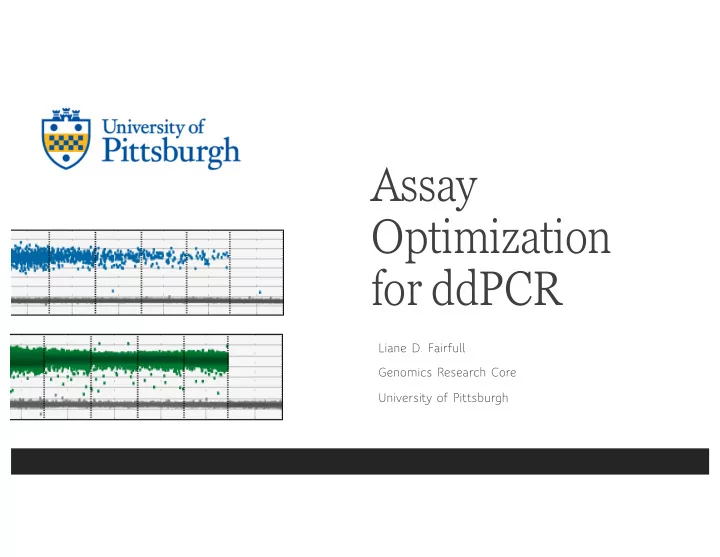

Assay Optimization for ddPCR Liane D. Fairfull Genomics Research Core University of Pittsburgh
Dr Droplet Di Digital PCR (ddP ddPCR): ): Absolute quantification of nucleic acids Bi BioRad QX QX200 System: • QX200 Auto Droplet Generator • C1000 Deep Well Thermocycler • QX200 Droplet Reader ü Probe-based assays ü EvaGreen-based assays Su Suggested Application ons: • Copy Number Variation • NGS Library Quantification • Gene Expression and miRNA analysis • Single Cell Validation • • Rare Sequence Detection Genome Edit Detection
Da Data: the Good, d, the Bad, d, and d the Ugly Images produced with BioRad’s QuantaSoft Pro Analysis Software Great! Needs some work… Start over L Optimized Multiplexed Assays Assays are not optimized No Controls ü Distinct band of positive droplets • No clear separation of • Only one band of signal is ü Distinct band of negative droplets positive and negative droplets observed ü Minimal “rain” • Positive signal is • Abundance of “rain” indistinguishable from • Lack of NTC and Positive Control negative signal
Re Reasons for Failed Ru Runs § Samples are underloaded or overloaded - Expected expression levels for target sequence and reference sequence? - Wide target input range 5 pg – 500 ng per sample § PCR isn’t working - Sample quality issues - the presence of inhibitors - RNA projects: Are we using the best RT kit? Sample degradation? - DNA projects: Are we using an appropriate restriction enzyme? § Design flaw - Assays are not compatible for multiplexing - Probes were made incorrectly (wrong dye, missing quencher) - RNA projects: Is there DNA contamination? Al Almost always a combination of these issues!
Re Required Controls Co Cont ntrols are e run n with all opt ptimization n tes ests and nd sampl ple e runs ns Positive Control (500 ng minimum)– preferably one sample that is selected by the investigator and expresses both target and reference sequences to verify the assays are working § Purchased Control DNA or RNA § Sample from your lab Ø Similar origin Ø Same extraction method as sample set Ø Stored and handled the same as sample set § gBlock or synthesized oligo construct may be needed for rare sequence detection * additional positive control required for reference sequence No Template Control (NTC) – Nuclease Free Water v Verify that there isn’t any cross-contamination v It provides a baseline of negative signal which helps in setting the threshold in QuantaSoft Analysis software
Sa Sample Quality Assessment DN DNA Samples RN RNA Sa Samples Purity (Nanodrop) Purity (Nanodrop) • 260/280 ratio at 1.8-2.0 • 260/280 ratio at 1.8-2.0 • 260/230 ratio at 2.0 • 260/230 ratio at 2.0 Perform sample clean up (Qiagen kit)? Perform sample clean up (Qiagen kit)? Integrity (Tapestation) Tapestation assessment is not • RIN above 6.0 typically done for DNA projects • Presence of DNA Perform DNase treatment? Concentration Concentration • If sample is clean use Nanodrop • If sample is clean use Nanodrop measurement measurement • If sample contains impurities run Qubit • If sample contains impurities run Qubit assay assay
Optimizing Sample Input Op Run a dilution series of the Positive Control to determine optimal input o Test assays separately o Possible range of input from nanograms (1 X 10 -9 ) to femtograms (1 X 10 -15 ) o Input levels Robust, clean for wells C01 signal in every and D01 are dilution step – the best good example of options for a reference this assay. assay. No separation of positive and Sample problem? negative signal despite sample PCR problem? dilution – something Assay Design issue? else may be wrong.
Mu Multiplex Testing Op Optimizing Thermocycling Conditions Using optimal input for Positive Control, run a o Example of assay temperature gradient to determine most efficient conditions annealing temperature optimized Test assays separately o separately that If necessary, number of cycles and length of o work well when anneal/extend time can be manipulated to improve multiplexed. signal Proceed with sample processing. Example of assays that were optimized separately but when combined are not working. Assay redesign or Well E01 is best annealing temp as shown by greatest amount of run assays in signal separation and least amount of rain. Well G01 is a NTC. separate wells.
To To Summarize… ddP ddPCR as assay ay opt ptimizat ation can an be a a very time consuming endeav avor but is crucial al for the su success ss of of every ddP ddPCR pr project ddPCR optimization is best achieved by: • Careful selection of target sequences including a reference sequence • Careful selection and design of assays • Choosing a positive control that best models your sample set • Sending adequate amounts (500 ng+) of the positive control and samples so that all optimizations can be completed and samples processed without interruption • Quality and quantity assessment of all samples and positive controls prior to testing • Rigorous optimization testing to determine optimal sample input and best thermocycling conditions • Inclusion of controls for every test and sample run Please note that client samples and reagents are always stored safely and appropriately. Any remaining samples will be promptly returned to the client following the completion of the project!
For any ddPCR questions or concerns please contact the Genomics Research Core at: Janette Lamb Deborah Hollingshead Liane Fairfull Director Assistant Director ddPCR jal18@pitt.edu hollings@pitt.edu fairfull@pitt.edu Erica Fong Yvette Rhodes Specimen Processing Specimen Processing esf14@pitt.edu ylr3@pitt.edu
Recommend
More recommend